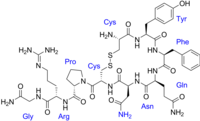
Photo from wikipedia
Apurinic/apyrimidinic endonuclease-1/redox factor-1 (APE1/Ref-1) is a multifunctional protein that can be secreted, and recently suggested as new biomarker for vascular inflammation. However, the endogenous hormones for APE1/Ref-1 secretion and its… Click to show full abstract
Apurinic/apyrimidinic endonuclease-1/redox factor-1 (APE1/Ref-1) is a multifunctional protein that can be secreted, and recently suggested as new biomarker for vascular inflammation. However, the endogenous hormones for APE1/Ref-1 secretion and its underlying mechanisms are not defined. Here, the effect of twelve endogenous hormones on APE1/Ref-1 secretion was screened in cultured vascular endothelial cells. The endogenous hormones that significantly increased APE1/Ref-1 secretion was 17β-estradiol (E2), 5????-dihydrotestosterone, progesterone, insulin, and insulin-like growth factor. The most potent hormone inducing APE1/Ref-1 secretion was E2, which in cultured endothelial cells, E2 for 24 h increased APE1/Ref-1 secretion level of 4.56 ± 1.16 ng/mL, compared to a basal secretion level of 0.09 ± 0.02 ng/mL. Among the estrogens, only E2 increased APE1/Ref-1 secretion, not estrone and estriol. Blood APE1/Ref-1 concentrations decreased in ovariectomized (OVX) mice but were significantly increased by the replacement of E2 (0.39 ± 0.09 ng/mL for OVX vs. 4.67 ± 0.53 ng/mL for OVX + E2). E2-induced APE1/Ref-1secretion was remarkably suppressed by the estrogen receptor (ER) blocker fulvestrant and intracellular Ca2+ chelator 1,2-Bis(2-aminophenoxy)ethane-N,N,N′,N′-tetraacetic acid tetrakis (acetoxymethyl ester) (BAPTA-AM), suggesting E2-induced APE1/Ref-1 secretion was dependent on ER and intracellular calcium. E2-induced APE1/Ref-1 secretion was significantly inhibited by exosome inhibitor GW4869. Furthermore, APE1/Ref-1 level in CD63-positive exosome were increased by E2. Finally, fluorescence imaging data showed that APE1/Ref-1 co-localized with CD63-labled exosome in the cytoplasm of cells upon E2 treatment. Taken together, E2 was the most potent hormone for APE1/Ref-1 secretion, which appeared to occur through exosomes that were dependent on ER and intracellular Ca2+. Furthermore, hormonal effects should be considered when analyzing biomarkers for vascular inflammation.
Journal Title: Biomedicines
Year Published: 2021
Link to full text (if available)
Share on Social Media: Sign Up to like & get
recommendations!